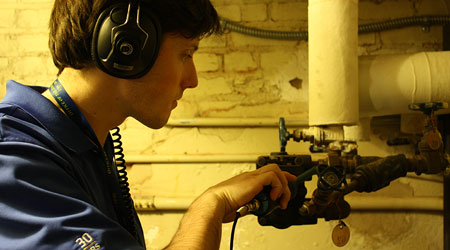How to Fix Ineffective Steam Traps
By repairing failing steam traps, facilities can save money and reduce their carbon footprint.
The first step when beginning a steam trap survey and replacement or repair project is organization. Ideally, the steam traps have unique identification tags, and the facility has a list of where all the steam traps are located.
In the absence of this information, the trap survey team should evaluate building drawings and draw on institutional knowledge to develop the list of traps. The survey team should have a laptop or tablet, with a database. Recommended database fields include building, room, location, trap tag number (if applicable), application, trap size, trap type, and conclusions. From this database, it is easy to add your annual mass flow loss and the annual cost.
How can we determine if a steam trap is working effectively? There are three primary and easy ways: thermal, visual, and acoustic evaluation.
With a simple infrared temperature scanner — commercially available for less than $50 — a steam trap can easily be evaluated. If the pipe immediately downstream of the steam trap is at or near the same temperature of the pipe upstream of the steam trap, the trap has failed. Live steam is getting past the trap. If the pipe downstream of the steam trap is warm, but not at the same temperature as the steam, it is a functional trap. If the pipe downstream of the steam trap is the same as ambient air temperature, the trap has failed in the closed position and is blocking condensate. This is a dangerous situation, and the trap should be replaced.
If there are valves in place that allow the downstream trap discharge to be sent straight to the atmosphere, the steam traps can be tested visually. Continuous flow of steam is indicative of a failed trap. Intermittent multi-phase flow is indicative of a working trap. If test valves are not available, the nearest condensate receiver may also give clues. A continuous, pressurized flow out of the condensate receiver vent or overflow is indicative of failed traps. The method to identify the problem trap is to work backwards from the condensate receiver, closing valves on the condensate return pipe and observing changes at the receiver.
Steam traps can also be evaluated acoustically with an ultrasonic scanner. The ultrasonic scanner is a probe that gets placed directly on the steam trap. The other end of the probe includes headphones, allowing the surveyor to listen to the internal operation of the trap. Functioning steam traps will typically have an intermittent whooshing sound, whereas a failed steam trap in the open position will sound continuously like a high-pitched steam leak. There are now commercially available, Bluetooth-enabled instruments which feed data directly to a surveyor’s mobile device. These instruments take the surveyor’s interpretation out of the equation and indicate failed steam traps.
As part of the steam trap survey, a variety of mismatched steam traps are likely to be found, especially around heat exchangers. Over time, as systems are repaired, the original designer’s intent can get lost. Without a clean tracking program, traps get replaced without proper measurements. Undersized steam traps will not adequately remove condensate, causing the condensate to back up, reducing heat exchanger effectiveness and risking a water hammer event.
An oversized steam trap is not an effective option either. An oversized steam trap will be unable to provide adequate shutoff at low loads, which ultimately causes the steam trap to leak.
Determine the capacity of the heat exchanger through nameplate data. In the absence of nameplate data, the heat exchanger should be engineered by comparing dimensions and observed temperature differentials to catalog data.
With heat exchanger sized, the steam trap can be sized. Some rules of thumb typically used are as high as 200 percent steam trap capacity compared to the design capacity of the heat exchanger, resulting in oversized steam traps. Based on current guidance from steam trap manufacturers, the recommended steam trap capacity is 105 percent to 150 percent of heat exchanger capacity.
Real-world case study at UMass Amherst
As part of a campus-wide steam and condensate survey at UMass Amherst, RMF identified a residential area of campus that was returning no condensate. Based on metered data, the direct annual cost was 108 million pounds of condensate, $289,000 in lost thermal energy, and 1,036 metric tonnes of CO2e. This was an ongoing vexing technical problem. Multiple experts recommended changes that didn’t work.
UMass Utilities correctly hypothesized the root cause as failed and incorrectly sized steam traps. The combined effect made the condensate system unusable. RMF reviewed every steam trap in this area, coordinated with manufacturers, and developed a design for replacement. The total rehabilitation project cost was approximately $683,000, for a simple economic payback of just 30 months. While this project is extraordinary in terms of payback, it demonstrates the benefit that can be had with a steam trap survey.
Steam trap evaluation and replacement is a relatively simple and effective way to save money on overall maintenance costs and improve a campus’ carbon footprint. An organized evaluation of the current system by an experienced and detail-oriented team can set the replacement project up for success. Finally, documenting all processes and updates are critical to future success and ease of repairs in the long term.
Dave Ohler is a mechanical engineer and project manager with experience in the design of steam distribution and generation systems. Since joining RMF’s infrastructure department in 2007, he has specialized experience in the design of pressure reducing stations and condensate recovery systems, specifically in areas with tight physical restrictions. His design duties typically include field verification, sizing, specification writing, drawing development, and thermal stress analysis. He is a licensed professional engineer and first-grade operating engineer in the state of Maryland.
Related Topics:













